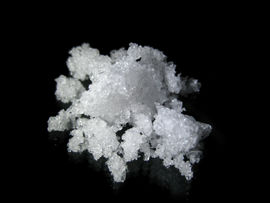Sodium hypophosphite

| |
| Names | |
|---|---|
| IUPAC name
Sodium phosphinate
| |
| Other names
Sodium phosphenite
| |
| Properties | |
| NaPO2H2 (anhydrous) NaPO2H2·H2O (monohydrate) | |
| Molar mass | 87.98 g/mol (anhydrous) 105.99 g/mol (monohydrate) |
| Appearance | Deliquescent white solid |
| Odor | Odorless |
| Density | 1.77 g/cm3 (monohydrate) |
| Melting point | 310 °C (590 °F; 583 K) (monohydrate) (decomposes) |
| Boiling point | Decomposes |
| 90 g/100 ml (20 °C) | |
| Solubility | Slightly soluble in aq. ammonia, ethanol, ethylene glycol, methanol Poorly soluble in propylene glycol |
| Solubility in ethylene glycol | 33.0 g/100 g (25 °C)[1] |
| Solubility in propylene glycol | 9.7 g/100 g (25 °C)[2] |
| Vapor pressure | ~0 mmHg |
| Hazards | |
| Safety data sheet | Sigma-Aldrich (monohydrate) |
| Flash point | Non-flammable |
| Lethal dose or concentration (LD, LC): | |
| LD50 (Median dose)
|
7,640 mg/kg (rat, oral) |
| Related compounds | |
| Related compounds
|
Hypophosphorous acid |
| Except where otherwise noted, data are given for materials in their standard state (at 25 °C [77 °F], 100 kPa). | |
| Infobox references | |
Sodium hypophosphite or sodium phosphinate is the sodium salt of hypophosphorous acid with the formula NaPO2H2. It is often encountered as the monohydrate, NaPO2H2·H2O.
Contents
Properties
Chemical
Sodium hypophosphite decomposes into phosphine which is highly irritating to the respiratory tract and disodium phosphate.
- 2 NaPO2H2 → PH3 + Na2HPO4
Sodium hypophosphite has been indicated to react explosively when triturated with chlorates.[3]
Physical
Sodium hypophosphite is a colorless hygroscopic solid, soluble in water.
Availability
Sodium hypophosphite is sold by chemical suppliers.
Sodium hypophosphite, like its parent compound hypophosphorous acid, is listed as List I precursor chemical in the United States, as it can reduce elemental iodine to form hydroiodic acid, which is a reagent effective for reducing ephedrine or pseudoephedrine to methamphetamine. Due to this restriction, the compound cannot be freely acquired by the hobby chemist in the United States.
Preparation
Careful addition of white phosphorus to a hot aqueous solution of sodium hydroxide yields sodium hypophosphite.
- P4 + 4 NaOH + 4 H2O → 4 NaPO2H2 + 2 H2
Phosphine is produced as side product. Since this gas is very toxic, this reaction must be done outside, away from houses or in a special fumehood, one that can remove harmful gaseous products.
Projects
- Reducing agent
- Make hypophosphorous acid
- Electroless nickel plating
Handling
Safety
Sodium hypophosphite is irritant and should be handled with care.
Storage
Sodium hypophosphite should be kept in a cool, dry place, isolated from oxidizing materials.
Disposal
Can be neutralized by dissolving it in water and then an oxidizer, such as hydrogen peroxide is added, which converts it to phosphate.
References
- ↑ O'Neil, M.J. (ed.). The Merck Index - An Encyclopedia of Chemicals, Drugs, and Biologicals. Cambridge, UK: Royal Society of Chemistry, 2013., p. 1601
- ↑ O'Neil, M.J. (ed.). The Merck Index - An Encyclopedia of Chemicals, Drugs, and Biologicals. Cambridge, UK: Royal Society of Chemistry, 2013., p. 1601
- ↑ O'Neil, M.J. (ed.). The Merck Index - An Encyclopedia of Chemicals, Drugs, and Biologicals. Cambridge, UK: Royal Society of Chemistry, 2013., p. 1601